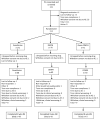Combined Stimulant and Guanfacine Administration in Attention-Deficit/Hyperactivity Disorder: A Controlled, Comparative Study
- PMID: 27453079
- PMCID: PMC4976782
- DOI: 10.1016/j.jaac.2016.05.015
Combined Stimulant and Guanfacine Administration in Attention-Deficit/Hyperactivity Disorder: A Controlled, Comparative Study
Abstract
Objective: Because models of attention-deficit/hyperactivity disorder (ADHD) therapeutics emphasize benefits of both enhanced dopaminergic and noradrenergic signaling, strategies to enhance D1 and α2A agonism may yield enhanced clinical and cognitive responses. This study tested the hypothesis that combined effects of a dopamine and noradrenergic agonist, d-methylphenidate extended-release (DMPH) with guanfacine (GUAN), an α2A receptor agonist, would be clinically superior to either monotherapy and would have equal tolerability.
Method: An 8-week, double-blind, 3-arm, comparative trial randomized 7- to 14-year-olds with DSM-IV ADHD to GUAN (1-3 mg/day), DMPH (5-20 mg/day), or a combination (COMB) with fixed-flexible dosing. Outcome measures were the ADHD Rating Scale IV (ADHD-RS-IV) and the Clinical Global Impression-Improvement (CGI-I) scale. Data on adverse events and safety measures were obtained.
Results: A total of 207 participants were randomized and received drug. Analyses showed significant treatment group main effects for ADHD-RS-IV ADHD total (p = .0001) and inattentive symptoms (p = .0001). COMB demonstrated small but consistently greater reductions in ADHD-RS-IV Inattentive subscale scores versus monotherapies (DMPH: p = .05; f(2) = .02; and GUAN: p = .02; f(2) = .02), and was associated with a greater positive response rate by CGI-I (p = .01). No serious cardiovascular events occurred. Sedation, somnolence, lethargy, and fatigue were greater in both guanfacine groups. All treatments were well tolerated.
Conclusion: COMB showed consistent evidence of clinical benefits over monotherapies, possibly reflecting advantages of greater combined dopaminergic and α2A agonism. Adverse events were generally mild to moderate, and COMB treatment showed no differences in safety or tolerability.
Clinical trial registration information: Single Versus Combination Medication Treatment for Children With Attention Deficit Hyperactivity Disorder (Project1); http://clinicaltrials.gov/; NCT00429273.
Keywords: ADHD; alpha2A; children; guanfacine; methylphenidate.
Copyright © 2016 American Academy of Child and Adolescent Psychiatry. Published by Elsevier Inc. All rights reserved.
Figures


References
-
- Wolraich ML, McKeown RE, Visser SN, et al. The prevalence of ADHD: Its diagnosis and treatment in four school districts across two states. J Atten Disord. 2014;18:563–75. - PubMed
-
- Biederman J, Petty CR, Woodworth KY, Lomedico A, Hyder LL, Faraone SV. Adult outcome of attention-deficit/hyperactivity disorder: a controlled 16-year follow-up study. J Clin Psychiatry. 2012;73:941–950. - PubMed
-
- Barkley RA, Fischer M, Smallish L, Fletcher K. Young adult outcome of hyperactive children: adaptive functioning in major life activities. J Am Acad Child Adolesc Psychiatry. 2006;45:192–202. - PubMed
Publication types
MeSH terms
Substances
Associated data
Grants and funding
LinkOut - more resources
Full Text Sources
Other Literature Sources
Medical
Miscellaneous

